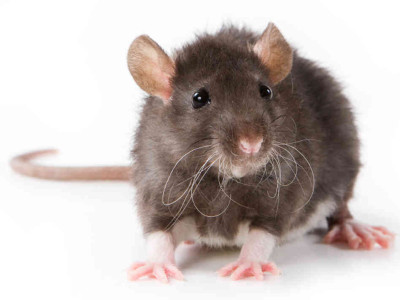 Situation may be prelude to another Ebola virus outbreak in West Africa
Situation may be prelude to another Ebola virus outbreak in West Africa
Lagos State Ministry of Health (LSMoH) in a public alert last week noted that Lassa fever is caused by infection with the Lassa virus, which is spread by rats that live in large numbers in West, Central, and East Africa. They carry the virus in their urine and faeces and live in homes and areas where food is stored
The fresh outbreak of another haemorrhagic fever (Lassa fever) across 10 states in the country, has killed over 40 persons and infected over 86, that is 46.51 per cent mortality rate, may be a prelude to possibly another outbreak of Ebola.
Reasons: Analysis shows the Ebola Virus Disease (EVD), Lassa fever, Dengue fever and Yellow fever are some of the haemorrhagic fevers that have been reported in Nigeria in the last three years; and that an outbreak of Lassa fever in early 2014 in Edo State and some other states heralded the Ebola outbreak in Lagos and Port Harcourt.
Several studies have shown that the spread of Lassa fever in a number of communities in different parts of the country was as a result of poor personal hygiene.
The primary animal host of the Lassa virus is the Natal multimammate mouse (Mastomys natalensis), an animal found in most of sub-Saharan Africa. The virus is probably transmitted by contact with the faeces or urine of animals accessing grain stores in residences.
Also, a new study published Tuesday in PLOS suggests that areas of increased poverty are associated with higher rates of Ebola virus transmission.
According to the study, since October 2014 the Ebola epidemic in West Africa has been diminishing and efforts have shifted from emergency response to prevention and mitigation of future outbreaks.
No vaccine for Lassa fever is currently available for use in humans, and the only available drug, ribavirin, is only effective if administered early in infection (within the first six days after disease onset).
Viral haemorrhagic fevers (VHFs) are a group of illnesses caused by four families of viruses. These include the Ebola and Marburg, Lassa fever, and yellow fever viruses. VHFs have common features: they affect many organs, they damage the blood vessels, and they affect the body’s ability to regulate itself.
According to the World Health Organisation (WHO), Viral haemorrhagic fever is a general term for a severe illness, sometimes associated with bleeding, that may be caused by a number of viruses. The term is usually applied to disease caused by Arenaviridae (Lassa fever, Junin and Machupo), Bunyaviridae (Crimean-Congo haemorrhagic fever, Rift Valley Fever, Hantaan haemorrhagic fevers), Filoviridae (Ebola and Marburg) and Flaviviridae (yellow fever, dengue, Omsk haemorrhagic fever, Kyasanur forest disease).
According to Wikipedia, Lassa frequently infects people in West Africa. It results in 300,000 to 500,000 cases annually and causes about 5,000 deaths each year. Outbreaks of the disease have been observed in Nigeria, Liberia, Sierra Leone, Guinea, and the Central African Republic.
Signs and symptoms
In 80 per cent of cases, the disease is asymptomatic, but in the remaining 20 per cent, it takes a complicated course.
The symptoms of Lassa fever typically occur one to three weeks after the patient comes into contact with the virus. These include fever, retrosternal pain (pain behind the chest wall), sore throat, back pain, cough, abdominal pain, vomiting, diarrhea, conjunctivitis, facial swelling, proteinuria (protein in the urine), and mucosal bleeding. Neurological problems have also been described, including hearing loss, tremors, and encephalitis.
Clinically, Lassa fever infections are difficult to distinguish from other viral hemorrhagic fevers such as Ebola and Marburg, and from more common febrile illnesses such as malaria.
The virus is excreted in urine for three to nine weeks and in semen for three months.
According to the Minister of Health, Prof Isaac Adewole, the first case of the current outbreaks was reported from Bauchi State in November 2015, followed by cases reported by Kano State and subsequently the other six states. Indeed, Nigeria has been experiencing Lassa fever outbreak in the past six weeks in Bauchi, Nasarawa, Niger, Taraba, Kano, Rivers, Edo and Oyo states.
Meanwhile, the Federal Government said measures had been put in place to curtail further spread and reduce mortality among those affected, however, ruled out placing travel restrictions from and to areas currently affected.
Former Health Minister, Prof. Onyebuchi Chukwu, had in April 2014, before the first case of Ebola was reported in July 2014, warned after outbreaks of Lassa fever: “… Some of these viruses belong to a group that causes similar diseases like yellow fever, which for 18 years now, we have not had a single case, but 18 years ago it devastated Nigeria.
“It is also the cause of what is called haemorrhagic fever, then Lassa fever which you know has been ongoing. There are even parts of Nigeria where it is endemic like the northern part of Edo State; they record a case every week and it is also very deadly.”
Challenges and gaps
According to the WHO, in the early stages, Lassa fever is often misdiagnosed as influenza, typhoid or malaria, and as a result many patients fail to receive appropriate medical treatment. Making a correct diagnosis of Lassa fever is made difficult by the wide spectrum of clinical effects that manifest, ranging from asymptomatic to multi-organ system failure and death. The onset of the illness is typically indolent, with no specific symptoms that would distinguish it from other febrile illnesses. Early signs include fever, headache and general malaise, followed by a sore throat, nausea, vomiting, abdominal pain and diarrhea in some cases. After four to seven days, many patients will start to feel better, but a small minority will proceed to display symptoms such as edema, hypertension, bleeding and shock. Death from Lassa fever most commonly occurs 10 to 14 days after symptom onset.
Meanwhile, Nigeria had through November 6, 2015, reported 270 Lassa fever cases from 12 states, according to data from Nigerian health officials. According to the Nigeria Centre for Disease Control (NCDC), two Lassa fever deaths were reported in Kano State, last month.
A nationwide outbreak of Lassa fever in the 10 states, in March 2014, had killed at least 20 people with about 319 reported cases.
The affected states were Anambra, Bauchi, Ebonyi, Edo, Gombe, Imo, Nasarawa, Ondo, Plateau and Taraba.
The Lassa virus was first described in 1969 in the town of Lassa, in Borno State, Nigeria.
Poverty and haemorrhagic diseases like Lassa fever and Ebola
Meanwhile, researchers from the Liberian Ministry of Health and the Yale Center for Infectious Disease Modelling and Analysis evaluated 3532 Ebola cases reported in 2014 in order to quantify the impact of poverty on the transmission and spread of Ebola. They found that areas stricken by extreme poverty were more likely to be associated with high rates of Ebola transmission and spread.
According to the study, in Monrovia, the capital of Liberia, 68 per cent of the population lives in slum neighborhoods characterized by overcrowding and lack of proper sanitation.
The researchers used two separate data sources to examine individuals reported as suspected, probable or confirmed Ebola cases. Communities were classified at three levels of socioeconomic status (high, medium and low) based on types of residence, sanitation availability and population density. A time-dependent stochastic model was used to evaluate transmission of the disease within and across the three different socioeconomic sub-populations.
However it was found that cases of Ebola in areas of low and middle socioeconomic status were associated with a higher number of personal contacts, increasing the likelihood of Ebola transmission. Ebola was also more likely transmitted from areas of lower socioeconomic status to higher ones, indicating that the disease is more likely to spread outwards from areas of poverty.
These findings suggest that areas of poverty can catalyze Ebola transmission both within and outside the community due to high contact with infected individuals and subsequently higher transmission rates. This provides a focus for Ebola prevention efforts in future. While areas of poverty often lack healthcare infrastructure, the researchers highlight that they have strong social networks that could be effectively used to engage community members in responding to outbreaks and combat emerging disease.
The researchers say while poverty has been associated with higher transmission rates during the 2014 Ebola outbreak it should not be seen as an insurmountable barrier to preventing the containment of future outbreaks.
According to the United States Centers for Disease Control and Prevention (CDC), Lassa fever is an acute viral illness that occurs in West Africa. The virus, a member of the virus family Arenaviridae, is a single-stranded RNA virus and is zoonotic, or animal-borne.
Lagos alerts residents
Meanwhile, worried about the outbreak of Lassa fever in some parts of Nigeria leaving many dead and others hospitalized, the Lagos State Ministry of Health has alerted residents on how to protect their lives and those of others around them.
Lagos State Ministry of Health (LSMoH) in a public alert last week noted that Lassa fever is caused by infection with the Lassa virus, which is spread by rats that live in large numbers in West, Central, and East Africa. They carry the virus in their urine and faeces and live in homes and areas where food is stored.
The ministry said people should suspect Lassa fever in persons who present above symptoms with a positive history of being in contact with a suspected or infected person or health worker who had treated either suspected or confirmed infected person.
Prevention and treatment
LSMoH, however, said Lassa fever could be treated. Antiviral drugs have been used successfully to treat Lassa fever. The earlier a person presents, the better the outcome of treatment.
For prevention and control of Lassa fever, the Lagos ministry urged the general public to:
*Avoid contact between rats and human beings.
*Observe good personal hygiene including hand washing with soap and running water regularly
*Disposal of waste properly and cleaning of the environment so that rats are not attracted
*Store foods in rat proof containers and cook all foods thoroughly before eating.
*Discourage rodents from entering the house by blocking all possible entry points
*For food manufacturers and handlers, do not spread food where rats can have access to it.
*The public should also report any cases of above symptoms or persistent high fever not responding to standard treatment for malaria and typhoid fever to the nearest health center.
*All fluids from an infected person are extremely dangerous. Health workers are also advised to be at alert, wear personal protective equipment, observe universal basic precautions, nurse suspected cases in isolation and report same to the Local Government Area (LGA) or Ministry of Health immediately.
Contacts in cases of emergency
For more information, the LSMoH said people should please contact the Directorate of Disease Control, Lagos State Ministry of Health on 08037170614, 08023169485.
Minister of Health advised: “Family members and healthcare workers are advised to always be careful to avoid contact with blood and body fluids while caring for sick persons. No travel restrictions will be imposed from and to areas currently affected.
“Healthcare workers seeing a patient suspected to have Lassa Fever should immediately contact the epidemiologist in the State Ministry of Health or call the Federal Ministry of Health using the following numbers- 08093810105,08163215251, 08031571667 and 08135050005.”






